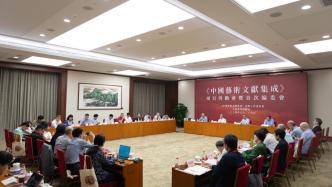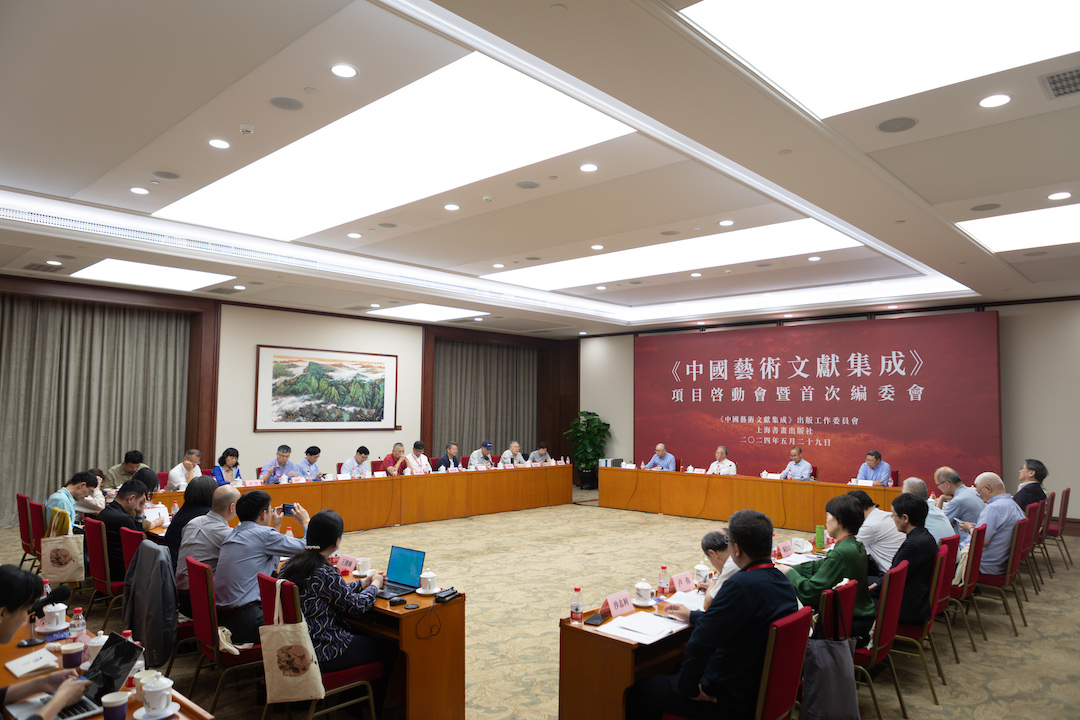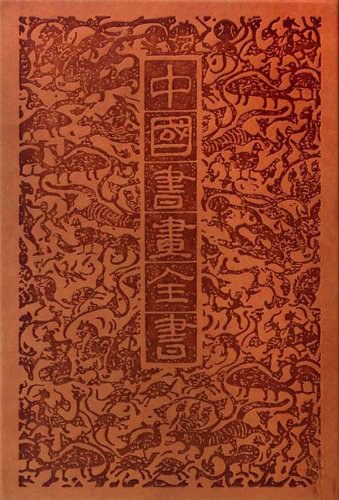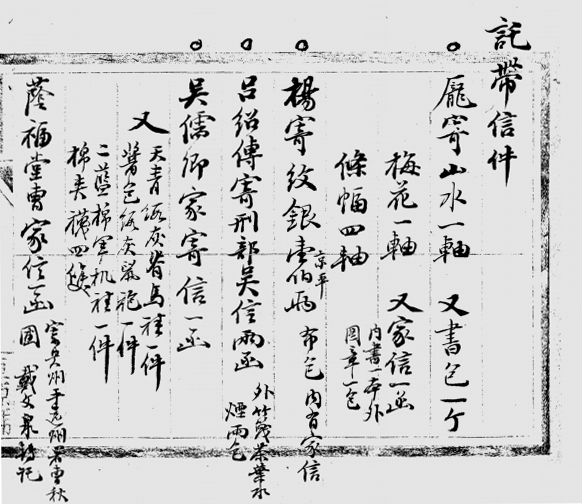
In recent years, my country has made great achievements in the compilation and publication of ancient books, and important achievements in the field of art documents have continued to emerge. However, ancient art documents with unique documentary value and cultural and artistic value are one of the few large-scale Chinese ancient books that have not been comprehensively investigated, compiled, and published, which brings difficulties to related academic research and teaching work.
The Paper has learned that in order to fill this gap, Shanghai Painting and Calligraphy Publishing House will plan and implement the largest-scale survey, classification, compilation and publication project of ancient art books, "Chinese Art Literature Collection", which can be called the "Siku Quanshu of Art". After nearly two years of preparation, the project kick-off meeting and the first editorial committee meeting were held in Beijing on May 29.
The largest-scale publishing project of ancient art books and documents has been launched
"Collection of Chinese Art Documents" is a large-scale art and ancient literature integrated publishing project planned and implemented by Shanghai Painting and Calligraphy Publishing House under the direct leadership and support of Century Publishing Group. It has been selected as the first batch of key publishing projects in the "National Ancient Books Work Plan 2021-2035" and the "14th Five-Year Plan" national key publications publishing planning project. With modern disciplinary concepts and technical means, it will conduct a comprehensive and systematic overall investigation of the ancient art documents in my country, and try to establish a new Chinese art document classic system with a clear context and the integration of traditional documents and modern disciplines, fill the gap in large-scale integrated document achievements and databases in the field of ancient Chinese art, and provide a systematic and solid document foundation for ancient art research.

The launch meeting of the project "Collection of Chinese Art Documents" and the first editorial committee
At the launching meeting, Kan Ninghui, president of Century Publishing Group, presented the appointment letter of chief editor to An Pingqiu, professor of Peking University, deputy leader of the National Ancient Books Compilation and Publishing Planning Leading Group, and honorary director of the National College Ancient Books Committee. He also presented appointment letters to the deputy editors-in-chief, members of the advisory committee and editorial committee who were present at the meeting.
An Pingqiu talked about his recommendations for the project participants. He believed that in terms of publishing, a Publishing Working Committee has been established, which is under the jurisdiction of the Compilation Office, the Advisory Committee and the Compilation Committee, all of which can play a role. The key to future work lies in organization and coordination, giving full play to the strength, and putting forward requirements in terms of format, selection, abstracts, specific undertakers and catalog indexes. Academic standards must be strictly adhered to, and research must be studied in the compilation process to ensure a careful beginning and a good end.

Kan Ninghui, president of Century Publishing Group, presents the appointment letter of chief editor to Professor An Pingqiu of Peking University
Kan Ninghui said that the project "Collection of Chinese Art Documents" has Shanghai style and century characteristics. Shanghai Century Publishing Group will fully support and guarantee the advancement of the project, making it a key project for Shanghai to build a peak in ancient book publishing.
The artistic documents of past dynasties have a deep connection with traditional classics and have unique documentary value and cultural and artistic value. They should be further developed and utilized in a systematic way. As one of the few large-scale Chinese ancient books that have not been comprehensively investigated, sorted, and published, art documents involve many modern disciplines and research fields, but they are often difficult to search, read, and use, which brings difficulties to related academic research and teaching. The academic community has been looking forward to the publication of high-level and systematic compilation of ancient art books.
After preliminary investigation and sorting, the bibliography of art literature has now included more than 5,000 titles. Tian Songqing, editor-in-chief of Shanghai Painting and Calligraphy Publishing House, said that the "Collection of Chinese Art Literature" will be based on a comprehensive and systematic investigation of ancient Chinese art literature, with the principle of selecting "historically influential" and "useful to us today" varieties, and with the professionalism of the experts of the compilation committee as a guarantee, sort out the development of ancient art literature, select literature varieties with publishing value, and use methods such as full-text photocopying and comprehensive compilation to form art literature sections such as calligraphy, painting, epigraphy, and seal carving, which will fully present the rich appearance of ancient Chinese art literature.
It can be called "the complete Sikushu of art"
It is reported that after more than two years of preliminary preparation, the "Collection of Chinese Art Documents" team has made a comprehensive survey of the art documents in China's existing ancient books as much as possible; combining basic classifications such as the "Siku Quanshu", "Zhongguo Congshu Zonglu" and "Zhongguo Gushu Zongcao" and modern academic concepts, it is initially planned to include five major categories of ancient Chinese art-related ancient books, such as calligraphy, painting, epigraphy, seal carving, and study records. The lower limit of time is 1911, and some documents can be appropriately postponed to maintain the continuity of the context.
The first editorial board of the project was chaired by Wang Lixiang, former president and editor-in-chief of Shanghai Painting and Calligraphy Publishing House. At the editorial board, more than 20 experts and scholars from major universities and museums and library systems such as Peking University, Tsinghua University, Fudan University, Zhejiang University, Nanjing University, Shandong University, Renmin University of China, Central Academy of Fine Arts, China Academy of Art, Jinan University, etc., made wonderful speeches and put forward valuable suggestions for the project.
Chen Zhenlian, vice chairman of the China Federation of Literary and Art Circles and professor at the School of Art of Zhejiang University, proposed that through the compilation of the "Collection of Chinese Art Documents", it is hoped that an independent discipline system of art documentation will be established, which is a true achievement of Mingshan's cause.

The Complete Book of Chinese Painting and Calligraphy was published by Shanghai Painting and Calligraphy Publishing House

Book cover of "Catalogue of Paintings and Calligraphy from the Huayin Pavilion"
Wang Lianqi, a research curator at the Palace Museum, said that Shanghai Painting and Calligraphy Publishing House had done a lot of work in the field of art documentation. Its previously published "Complete Chinese Painting and Calligraphy" was a commonly used source of art documentation. Now they are creating the "Collection of Chinese Art Documents", which can be called the "Siku Quanshu" of art. It is of great significance and difficulty, and should be considered as carefully as possible.

"Collection of Epigraphy Manuscripts" (three volumes, 82 volumes in total) published by Shanghai Painting and Calligraphy Publishing House
Professor Fan Jingzhong of the China Academy of Art particularly talked about the importance of version selection and abstract writing, and pointed out that "the academic benchmark for a country and a nation is art history, because only when the research level of literature, history, philosophy and other disciplines has reached a certain level, can art history keep up." "Collection of Chinese Art Documents" is a cause that is related to the future development of art history, and we must move forward step by step.


